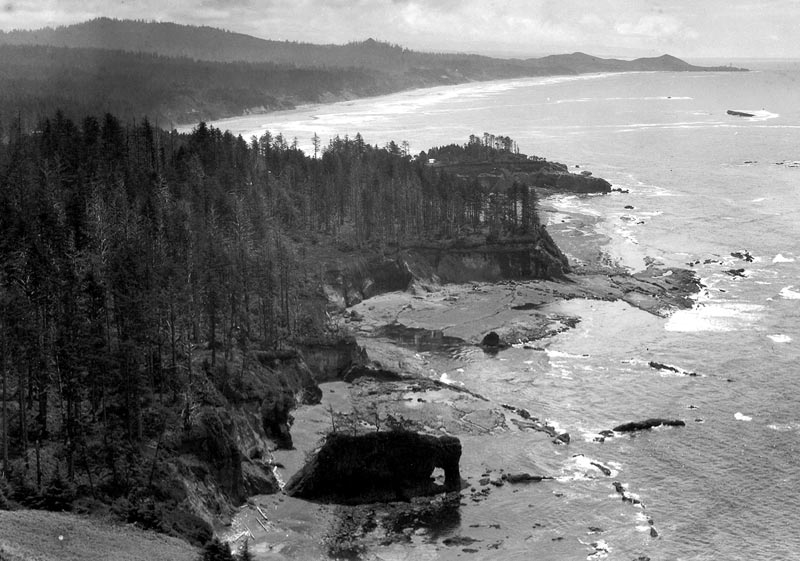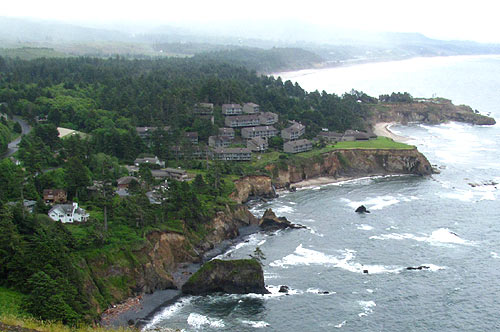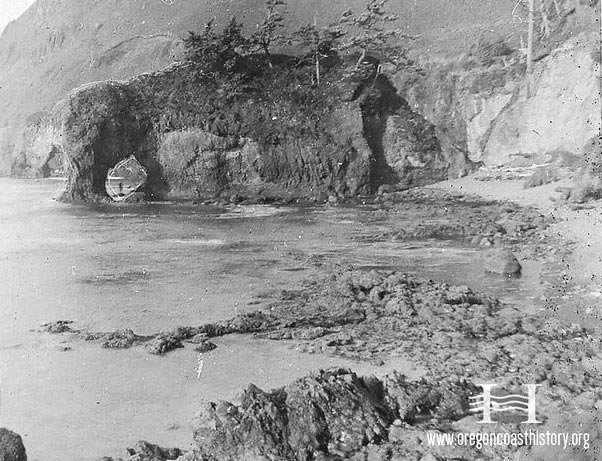Surprise-Filled History Surrounds Oregon Coast Landmark: Elephant Rock, Devil's Punchbowl, Otter Crest
Virtual Tour of Depoe Bay, Gleneden Beach, Lincoln Beach, Otter Rock, Oregon Coast

The old Elephant Rock is pictured above: photo courtesy Lincoln County Historical Society
While the Devil's Punchbowl, on the central Oregon coast, has been a heavy favorite among visitors for generations, there was actually another rock structure nearby that had the attention of tourists for quite a while before it.
Then, in an eerie twist, a purported curse seemed to come true upon the destruction of this landmark, which now sits at a beach that’s not really accessible anymore.
Right below the tiny community of Otter Rock, just north of Newport, there was a rock structure named Elephant Rock, which looked significantly similar to an elephant with its trunk dipped into the water. According to a 1936 local newspaper article, Elephant Rock was quite a draw to tourists, who snapped many a picture of the charming formation.
Then, sometime before the article’s publication date of February 1936, Elephant Rock was beheaded by a winter storm, altered forever as so many favorite coastal landmarks have been in these decades since Europeans began settling here. The article talks about the headland’s only resident looking sadly upon the rocky remnant of a departed old friend.

And this is when a curse fell on the area – but more on that in a bit. (Above: the same view presently and what's now left of Elephant Rock)
According to Jodi Weeber with the Lincoln County Historical Society in Newport, there’s a native tribe legend that supposedly goes with the rock, saying there was once a massive fire in the area that destroyed a lot of land. This was the “Fire Demon,” as it was known, and the “Great Spirit” of the local people went to battle with it.

The old Elephant Rock is pictured above: photo courtesy Lincoln County Historical Society
Somehow, the last of the woolly mammoths – so the legend goes – joined the fray, and beat the fire demon at the base of Otter Crest (it undoubtedly was not named that by local tribes) by dipping its trunk into the water and hosing down the flames.
From then on, the Great Spirit decided that this noble elephant, or woolly mammoth – or whatever – would stand guard against the fire demon. He was placed there in stone.
The legend says something to the effect that the local people and their forests – from Yachats to the Siletz River by Lincoln City – would be protected as long as Elephant Rock stood and as long as they kept tradition.
In a cruel, almost paranormal twist, bad luck hit the tribes bigtime once Elephant Rock crumbled. The article notes that the reservations for the Siletz and Grand Ronde Indians were dissolved right around this time.
Shortly after Elephant Rock’s head was lost, there were major fires all around the coast, said Jodi Weeber, with the Lincoln County Historical Society (back in the early 2010's).
“One burnt down the hill to Depoe Bay, another big one burned between Waldport and Yachats, and there was the big one in Bandon that year,” Weeber said. “Two years later, there was the fire in Tillamook.”
This all, of course, begs the question: how did local tribes know about woolly mammoths way back?
Weeber said she didn’t know and laughed.
“Sounds like a white man thing to me,” Weeber said. “There were a lot of stories written by the white man who say they were an Indian tale, like Jump-Off Joe at Newport.”
Weeber said there is nothing in the records that shows how Devil’s Punchbowl got its name or who first discovered it.
That rock structure called Elephant Rock – or what’s left of it – still sits on this beach, but sadly it’s only accessible by those staying at the Inn at Otter Crest facility, as they’ve created the stairway. It is the only access to this portion of the beach (an outcropping blocks entrance from the marine gardens side). This makes it one of the few beaches in Oregon which has wound up not completely public simply by circumstances of accessibility. While it is public, technically, it's only reachable by a private stairway.
Elephant Rock lies on the other side of another outcropping to the north. Even it is not usually accessible because of either tidal conditions or the bedrock there is so covered in slippery green goo it's impossible to walk on safely.
